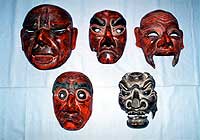
| Pseudonym reading | Buganen |
|---|---|
| Specified type | Prefecture designation |
| Type | Sculpture |
| Designated date | September 1, 1995 |
| Specified details | |
| quantity | 1 case 10 points |
| location | Ninohe City Johoji Town Oyama character Oyama Kubo |
| owner | Tendai-ji Temple |
| Holding group | |
| Management organization | |
| home page | Iwate Prefectural Museum (Tendai-ji Temple Mairaku "Lingo") Ninohe City (Hachihayama Tendaiji Temple) |
Overview
As an ancient performing arts, the dance that came a little later than the pleasure is said to be the mask used for the music and the accompanying dance that were prevalent in the Chinese mainland and the Korean peninsula.
It is difficult to identify the place of each outbreak, and some of them can be found in the west and south beyond the Korean peninsula and the mainland of China, and also the origin can be sought for India.
In addition, some traditional dances such as Kume dance and dance in ancient Japan, five passages dance for praying for five grains in various rural areas, and east excursions in the eastern part of Japan are incorporated, and they have different aspects to pleasure and later performances. It is characterized by having a dance.
Generally, dance music is divided into four types: dance and dance accompanied by an active dance and an active dance, and dance and dance.
However, of these, the ones that use masks are part of running dance and taking dance, and are limited to cases that can not be represented by an ordinary human face.
The mask is filled with the expectation as a person with high psychic ability to defeat evil spirits.
Expectations for such majestic power would have been further strengthened by the introduction of the alien aspect.
There are many things that have been played along with pleasure since the Nara period, and when pleasure is over in the Heian period, dance music reaches a high season as a shrine and temple music including the court, and it is transmitted to local temples, We came to look at the distribution of the artifacts.
The ten faces remaining at Tendai-ji Temple may not be a single piece of equipment at the same time, but they may be said to be remnants with a considerable time lag, but considering the history that scatterers and honors have been transmitted as faces of god of evil spirits, such The works of the main temple, including objects, are rare in the region even in terms of number, and each feature a feature on the work that demonstrates the study with folk performing arts, and it is a valuable relic to consider the development of dance music in Japan. It can be said that there is.
image

